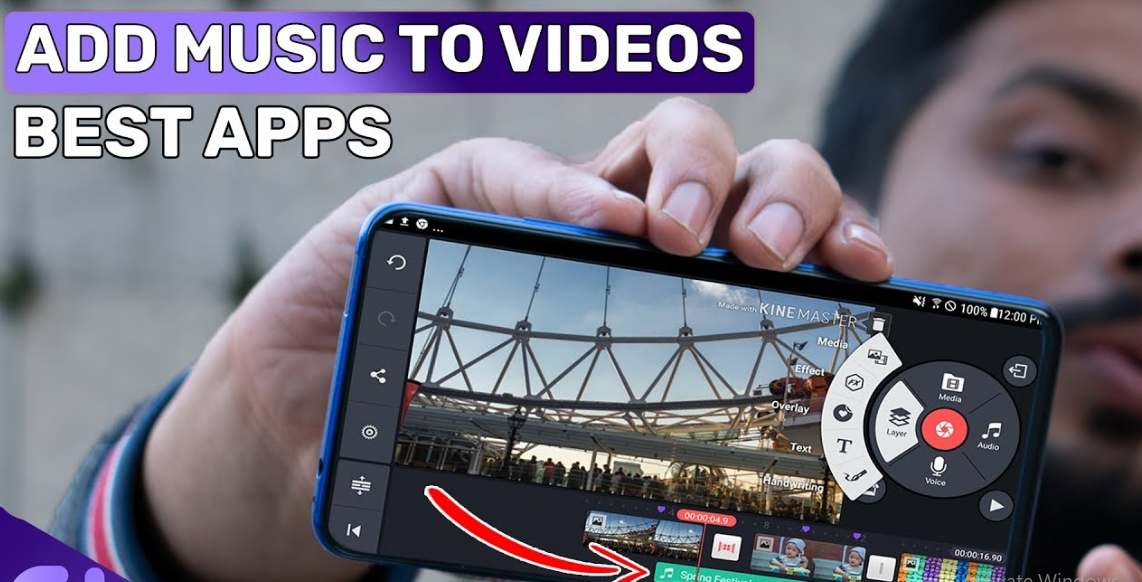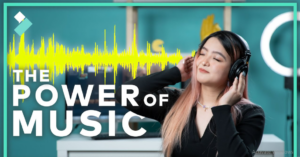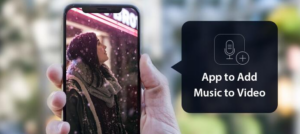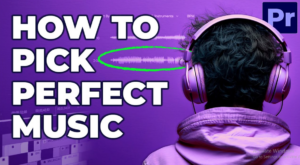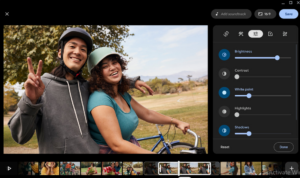samwyche.com – App For Add Music In Video! In today’s digital age, the art of storytelling has evolved, and videos have become a powerful medium for conveying messages, sharing experiences, and expressing creativity. Whether you’re documenting life’s memorable moments, engaging your audience through social media, or promoting your brand, the impact of a well-crafted video cannot be overstated.
Yet, while visuals play a vital role in capturing attention, there’s another element that has the remarkable ability to elevate your videos to new heights: music. Music has a unique power to evoke emotions, set the mood, and create a deeper connection with your audience. It turns a sequence of images into a cinematic experience and transforms mundane clips into captivating narratives.
Enter the world of mobile apps, where technology meets creativity, and anyone with a smartphone can become a video producer. In this guide, we’ll explore the fascinating realm of “Apps for Adding Music to Video.” We’ll unveil the potential of these applications to infuse your videos with the magic of music, all at your fingertips.
From adding a touch of background music to full-scale music video production, these apps offer a wide spectrum of possibilities. Whether you’re a novice looking to enhance your storytelling skills or a seasoned content creator seeking new ways to engage your audience, this guide has something for everyone.
Throughout this journey, we’ll delve into the reasons why music is a crucial component of video creation. We’ll discuss the types of apps available, guiding you through the process of selecting the one that best suits your needs. You’ll learn how to import and edit music seamlessly into your videos, creating an auditory and visual symphony that leaves a lasting impression.
The Power of Music in Videos
App For Add Music In Video! When it comes to crafting memorable and emotionally resonant videos, music stands as one of the most potent tools in your creative arsenal. It’s not just an optional element or a background feature; it’s an essential component that can transform your videos into compelling narratives. Here’s a closer look at the profound impact of music on your visual storytelling:
1. Evoking Emotions:
- Music has a unique ability to stir emotions in your viewers. It can make them laugh, cry, feel excited, or experience a sense of nostalgia. The right piece of music can amplify the emotions you want to convey in your video, creating a deeper connection with your audience.
2. Setting the Mood:
- Music serves as a powerful mood-setter. It can instantly establish the tone of your video, whether it’s a lighthearted comedy, an intense action sequence, or a heartwarming family moment. The choice of music influences how viewers perceive and engage with your content.
3. Enhancing Storytelling:
- Just as a good book weaves words to tell a story, music can weave melodies to enhance your video’s narrative. It can accentuate plot developments, highlight key moments, and provide a cohesive thread that ties your video together.
4. Captivating Attention:
- In the age of short attention spans, captivating your viewers from the very beginning is crucial. Music can act as a hook, drawing viewers in and encouraging them to stay engaged with your video.
5. Creating Atmosphere:
- Music has the power to transport viewers to different places and times. Whether you’re showcasing a tranquil beach scene, a bustling city, or a mysterious forest, the right music can create a vivid atmosphere that immerses your audience in your video’s world.
6. Adding Depth and Texture:
- Music isn’t just about melody and harmony; it also brings texture and depth to your videos. The interplay between different instruments, rhythms, and melodies can create a multi-dimensional experience that resonates with viewers.
7. Enhancing Visual Impact:
- Music can influence the way viewers perceive visuals. It can make a simple scene feel epic, heighten suspense in a thriller, or make a joyful moment even more delightful. It complements the visual elements and amplifies their impact.
8. Strengthening Brand Identity:
- For businesses and content creators, consistent use of music can help strengthen brand identity. A signature musical theme or sound can become synonymous with your brand, making your content instantly recognizable.
In essence, music is not just an accompaniment to your videos; it’s a storytelling partner. It adds depth, emotion, and resonance to your visual narratives. The careful selection and synchronization of music can turn a good video into an unforgettable one.
App For Add Music In Video
Now that you’ve explored the different types of apps available for adding music to your videos, it’s time to get started with the app of your choice. In this section, we’ll walk you through the process of downloading and installing the app on your device.
1. Choose the Right App:
- Before you can download and install an app, you need to decide which one aligns best with your needs. Consider factors like your device’s operating system (iOS, Android, Windows, etc.), your familiarity with video editing, and your budget.
2. Visit the App Store:
- Depending on your device, you can find apps on the respective app stores:
- For iOS (iPhone and iPad users), go to the Apple App Store.
- For Android users, visit the Google Play Store.
- For desktop editing, you may need to download software directly from the developer’s website.
3. Search for the App:
- Use the search function within the app store to look for the app you’ve selected. You can either type in the app’s name or keywords related to video editing and music.
4. Download the App:
- Once you’ve found the app, tap or click on the “Download” or “Install” button. The app will begin downloading to your device.
5. Sign In or Create an Account (if required):
- Some apps may require you to create an account or sign in with an existing one. Follow the on-screen instructions to complete this step.
6. Grant Permissions (if prompted):
- Depending on the app’s features, it may request access to your device’s camera, microphone, and storage. Be sure to grant the necessary permissions to ensure the app functions correctly.
7. Install Updates (if available):
- Before you start using the app, it’s a good practice to check for updates. App developers often release updates to improve performance and add new features. Make sure your app is up to date for the best experience.
8. Familiarize Yourself with the Interface:
- Once the app is installed, open it and take some time to explore the interface. Familiarize yourself with the various menus, buttons, and features. Many apps provide introductory tutorials or help sections to get you started.
9. Begin Adding Music:
- Now that you have the app installed and are acquainted with its interface, you’re ready to start adding music to your videos. The next steps will involve importing your video clips and selecting the perfect music tracks to complement them.
Congratulations! You’ve successfully downloaded and installed the app of your choice, and you’re one step closer to creating captivating videos with music. In the following sections, we’ll guide you through the process of importing your video clips and selecting the perfect music to enhance your storytelling.
Selecting the Perfect Music
Now that you have your video editing app ready, it’s time to embark on the exciting journey of selecting the perfect music for your videos. The choice of music can make or break the emotional impact and engagement level of your content. Here’s how to pick the ideal soundtrack:
1. Understand Your Video’s Message and Mood:
- Before diving into your app’s music library, take a moment to reflect on your video’s message and the mood you want to convey. What emotions are you aiming to evoke in your audience? Is your video meant to be inspirational, joyful, sentimental, or suspenseful? Understanding the essence of your video is the first step in choosing the right music.
2. Explore the Music Library:
- Open your video editing app and access its music library. Browse through the available tracks and listen to samples. Pay attention to the titles, descriptions, and genres to identify music that aligns with your video’s theme.
3. Match the Tempo and Rhythm:
- The tempo and rhythm of the music should sync with the pacing of your video. Upbeat, energetic music suits fast-paced videos like action sequences or travel vlogs, while slower, more melodic tunes work well for introspective or emotional content.
4. Consider Instrumentation:
- Different musical instruments can evoke different emotions. For instance, acoustic guitars and pianos often create a warm, intimate atmosphere, while electronic beats can add excitement and energy. Consider the instrumentation that complements your video’s visuals.
5. Think About Lyrics (or Lack Thereof):
- If your video contains voiceovers, dialogue, or narration, be mindful of the lyrics in the music. Lyrics can clash with spoken content, so opt for instrumental music or tracks with non-intrusive vocals in such cases.
6. Create a Musical Arc:
- Just as your video has a beginning, middle, and end, your music should follow a similar structure. Start with a gentle introduction, build up to a peak moment, and gradually fade out for a satisfying conclusion. A well-structured musical arc enhances the overall viewing experience.
7. Test with Different Tracks:
- Don’t settle for the first music track that seems suitable. Experiment with multiple tracks to see which one resonates best with your video’s narrative and emotional flow. Sometimes, a different track can completely transform the video’s impact.
8. Check Licensing and Copyright:
- Ensure that the music you choose is either royalty-free or properly licensed for your intended use. Using copyrighted music without permission can lead to legal issues and content removal.
9. Seek Feedback:
- Share your video with a few trusted friends or colleagues and gather their feedback on the music choice. Different perspectives can help you refine your selection and ensure it resonates with a wider audience.
Remember, the perfect music track can elevate your video to new heights, enhancing its emotional impact and creating a lasting impression on your audience. Take your time in this selection process, as the right music can make your video truly unforgettable.
In the next section, we’ll guide you through the steps to add the chosen music to your video, ensuring a seamless integration that enhances your video’s storytelling.
Additional editing features in the app
While the primary focus of video editing apps for adding music is, of course, the music integration itself, many of these apps come equipped with a range of additional editing features. These features can help you enhance your videos further, giving you more creative control over the final result. Here are some common additional editing features you might find:
1. Video Enhancement Tools:
Many video editing apps offer tools to enhance the visual quality of your videos. You can adjust brightness, contrast, saturation, and sharpness to improve the overall look of your footage. These tools are particularly useful for correcting exposure issues or giving your videos a consistent color tone.
2. Transitions:
Transitions are effects that connect one video clip to another seamlessly. Common transitions include fade-ins, fade-outs, crossfades, slide transitions, and more. Using transitions effectively can make your video flow smoothly from one scene to the next.
3. Text and Titles:
Add text overlays and titles to your video to provide context, introduce segments, or highlight key points. You can customize fonts, colors, sizes, and animations to make your text visually appealing.
4. Filters and Effects:
Apply filters and special effects to give your video a unique look and feel. These effects can range from vintage and retro filters to more abstract and artistic choices. Experiment with different effects to enhance your video’s visual impact.
5. Speed Control:
Adjust the speed of your video clips to create dramatic or comedic effects. You can slow down or speed up specific segments to match the music’s tempo or to emphasize particular moments in your video.
6. Voiceovers and Audio Editing:
In addition to adding music, you can record voiceovers directly within the app. This feature is useful for narration, commentary, or adding additional context to your video. You can also edit audio tracks, remove background noise, or adjust volume levels.
7. Layering Multiple Audio Tracks:
Some advanced video editing apps allow you to layer multiple audio tracks. This feature is valuable for adding sound effects, ambient noise, voiceovers, and music simultaneously, creating a rich auditory experience.
8. Stabilization:
If you have shaky footage, stabilization tools can help smooth out the camera movements, making your video appear more professional. This is especially useful for action or handheld shots.
9. Trimming and Cutting:
Precisely trim and cut your video clips to remove unwanted sections or create seamless transitions. This feature is essential for refining the pacing and timing of your video.
Exploring these additional editing features in your chosen app can take your video creation to the next level. While music plays a significant role in storytelling, these tools allow you to fine-tune the visuals, audio, and overall presentation of your videos, ensuring a polished and engaging final product.
Advanced Tips and Tricks
While the basics of adding music to your videos are essential for creating engaging content, there are advanced techniques and creative strategies that can take your video editing skills to the next level. These tips and tricks will help you unlock the full potential of music integration and elevate your video production game:
1. Create a Music Palette:
- Instead of relying on a single music track, consider creating a palette of multiple tracks that you can use throughout your video. This allows you to match different moods and scenes with appropriate music seamlessly.
2. Leverage Sound Effects:
- In addition to music, incorporate sound effects into your video. Sound effects can enhance the immersion and add depth to your storytelling. For example, include the sounds of nature in outdoor scenes or the clinking of glasses in a celebratory moment.
3. Use Music as a Narrative Element:
- Think of music as an integral part of your storytelling. Use it to foreshadow events, build tension, or emphasize emotional moments in your video’s narrative.
4. Experiment with Tempo and Rhythm:
- Alter the tempo and rhythm of your video to match the music. For instance, you can edit your video to have faster cuts and transitions during high-energy music segments and slower, more lingering shots during quieter parts of the track.
5. Create Custom Music Mixes:
- If you have some music production skills or access to a musician, consider creating custom mixes or remixes of existing tracks. This allows you to tailor the music even more precisely to your video’s needs.
6. Add Lyrics for Impact:
- If your video’s theme aligns with a particular song’s lyrics, consider adding text captions that display the lyrics as the song plays. This can create a powerful emotional connection with the audience.
7. Incorporate Dynamic Music Changes:
- For longer videos, such as documentaries or vlogs, use dynamic music changes to keep the viewer engaged. Switch between different music tracks to match the evolving storyline or mood.
8. Layer Multiple Audio Tracks:
- Some video editing apps allow you to layer multiple audio tracks. Use this feature to combine music, voiceovers, sound effects, and ambient noise for a rich audio experience.
9. Play with Sound Design:
- Experiment with audio effects and sound design to create unique and memorable auditory moments. This might include echo effects, reverberation, or even manipulating the pitch of certain audio elements.
Remember, while these advanced tips and tricks can enhance your videos, the key is to maintain a balance between audio and visuals. The ultimate goal is to create a cohesive and impactful video that resonates with your audience while delivering a memorable audio-visual experience. Explore these techniques and adapt them to suit your creative vision and storytelling goals.
Conclusion
As we conclude our journey through the world of adding music to videos, it’s clear that the fusion of visuals and music is nothing short of magical. We’ve embarked on a creative adventure, uncovering the art and science of transforming ordinary videos into captivating stories that resonate with audiences on a profound level.
Throughout this guide, we’ve equipped you with the knowledge and tools needed to master the craft of adding music to your videos. From choosing the right app to selecting the perfect music and applying advanced techniques, you’ve gained a solid foundation for video editing and storytelling.
We’ve explored the power of music in videos, recognizing it as a dynamic force that can evoke emotions, set the mood, and enhance storytelling. Music isn’t merely a background element; it’s a narrative partner that elevates the impact of your content.
In your quest to create compelling videos, you’ve learned to navigate app options, download and install your chosen tool, and select music that resonates with your audience. You’ve also discovered advanced techniques that allow you to use music as a storytelling tool, experiment with sound design, and create soundtracks for brand consistency.
As you continue your creative journey, remember that practice is key to mastery. Each video you produce is an opportunity to refine your skills, experiment with new ideas, and connect with your audience in a meaningful way.
Thank you for joining us on this creative journey through “App for Adding Music to Video.” We wish you success, inspiration, and endless creativity in your video endeavors. Happy editing and storytelling!
